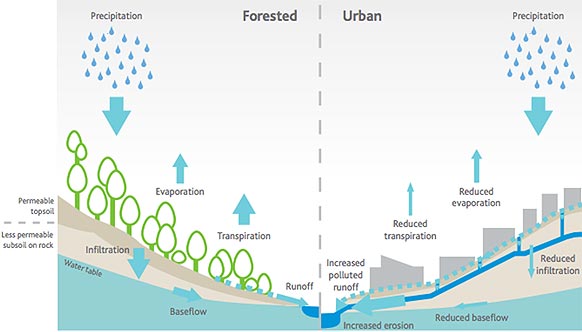Stormwater is rainwater that has fallen onto roads or roofs and often contains chemicals or pollutants. Water sensitive urban design (WSUD) is an approach to planning and designing urban areas to make use of this valuable resource and reduce the harm it causes to our rivers and creeks.
Impacts of stormwater on waterways
In natural environments, rainwater mostly evaporates, gets absorbed by plants or soaks into the ground. Urban development dramatically changes these processes, clearing land of vegetation and covering it with 'hard' or impervious surfaces that cannot let water through.
As a result, rainwater runs off these surfaces, through stormwater drains and straight into our waterways as polluted stormwater in a very short time. This changes the timing, speed and volume of water flows, which can affect our waterways and bays.

Some of these impacts include:
-
causing waterways to have reduced flows most of the time and higher, unnatural flows for a few hours after it rains
-
making beaches unsuitable for swimming for 1-2 days after heavy rain
-
changing the habitat of dolphins, platypus, fish and aquatic animals, and affecting their breeding habits
-
eroding stream banks and degrading streams
To reduce these negative impacts, residential subdivisions must meet stormwater management objectives outlined in Clause 56.07-4 of the Victorian Planning Provisions:
Water sensitive urban design approach
Water sensitive urban design (WSUD) uses better urban planning and design to reuse stormwater, stopping it from reaching our waterways by mimicking the natural water cycle as closely as possible.
WSUD options
WSUD works at all levels – lot, street and precinct – as well as regional scales. It includes a range of treatment options.




